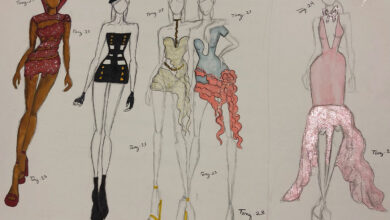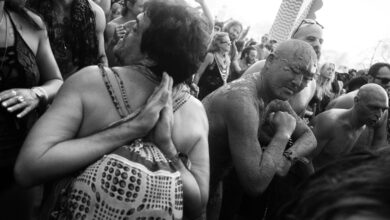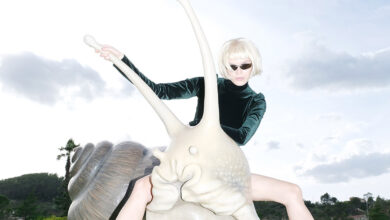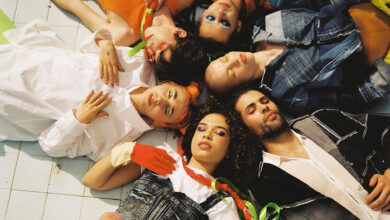Zoot Magazine looks at a recently opened exhibition at the Groningen-based Noorderlicht Photogallery that rediscovers the work of some of the most iconic fashion photographers.
Text by Anna Battista
Models locked in bubbles softly float in the sky over New York and Paris; girls in Optical Art-inspired designs sunbathe next to the pyramids while sensual women pose surrounded by intricately carved Indian and Moroccan buildings. These aren’t visions borrowed from extremely stylish dreams, but real photo shoots, part of the exhibition “Fashion – The Story of a Lifetime” currently on at the Groningen-based.
Curated by photo specialist Hester Keijser and co-produced with The Empty Quarter Gallery in Dubai, the event features iconic fashion shoots by international fashion photographers such as Lillian Bassman, F.C. Gundlach, Frank Horvat, William Klein, Sarah Moon, Norman Parkinson, Melvin Sokolsky and Albert Watson. The fifty images exhibited in the gallery are selected from different decades and, while providing the visitors with some interesting fashion knowledge about how Haute Couture and ready-to-wear changed throughout the times, they also allow to rediscover the art of famous photographers, including F.C. Gundlach’s orientalist work, William Klein’s dynamic motion style photography and Sarah Moon’s meditatively evanescent portraits.
Zoot Magazine: Is this the first time the Noorderlicht Photogallery organises an exhibition about fashion?
Hester Keijser: The Noorderlicht Photogallery is an international platform for photography which aims to couple engagement with visual beauty. Although usually a home for documentary projects with a strong narrative, “Fashion – The Story of a Lifetime” certainly fits within the Noorderlicht exhibition program. Of course there is plenty of glamour, Haute Couture and exquisite beauty from the heydays of fashion to feast your eyes on, but there is also a reflective undercurrent focusing on the lifelong careers of photographers who have grown up and grown old with changing fashion trends.
Zoot Magazine: How long have you been researching this exhibition?
Hester Keijser: This exhibition is a sequel to a highly successful event that I helped putting together for The Empty Quarter Gallery (www.theemptyquarter.com) in Dubai last year. It took us almost one year to select and trace down the photographers or their representing galleries, and then persuade them to give these often very costly and fragile prints on loan. We’ve been truly lucky to find such generous donors, without whose trust such gatherings of historical material would never have happened. This is an aspect that tends to be overlooked in an age where photographs have become freely available for viewing on the Internet, and where everything can be bought almost instantly. Everyone can dial a pizza, but not everyone can dial a monumental Gundlach, a vintage Horvat or a set of Lillian Bassman’s!
Zoot Magazine: Which are your favorite photographs featured in the exhibition and why?
Hester Keijser: These are always very personal questions and purely a matter of subjective taste. If you spend such a long time researching the work, your allegiances vary with the season. Sokolsky’s iconic bubble images speak to the child in me with their playfulness and innocence, The roulette strategy wheel consists of numbers 1 through 36, alternately colored red and black, plus 0, which is green, plus Marvel Bonus position, which is blue. whereas Bassman’s feminine sensuality awakes a very different nostalgia. As a weathered viewer and demanding photo specialist I’m maybe more drawn to the complexity of Frank Horvat’s images, which would look equally well in Vogue, a classic suspense movie or a factual documentary on famous designers at work.
Zoot Magazine: Is there anything about any of the photographers exhibited you discovered that you didn”t know while researching for this exhibition?
Hester Keijser: But of course! That’s one of the exciting things that I love about my work as an independent photo curator. You get to delve into a new world with each project. The most surprising aspect to uncover for me was the extent to which Haute Couture has been and increasingly is at home in the Middle East. In Dubai, the exhibition was in part a tribute to one of the fashion pioneers in Saudi Arabia, Parveen Shaath, who had traveled all her life to fashion houses in Europe and Asia to bring home prêt-à-porter and Haute Couture for the high society. Very few people realise that, today, under their black abayas, many Muslim ladies wear daring creations by top designers. Moreover, there are a number of well-known fashion houses who could not have survived the financial crisis without substantial financial injections from investors from the Muslim world. This influence goes both ways. Let”s recall, for example, the splendid, Bedouin-inspired Winter 2010 collection by Givenchy. Alexander McQueen is another name that often gets mentioned as an inspiration for the modern Muslim fashionista. The roots for these recent developments can be traced back to the rise of fashion as pop culture in post-war Europe and the US. The images in this show testify of this “secret history” of meeting points between the East and the West.
Zoot Magazine: How important are the works exhibited at the gallery in today”s fashion perspective and in which ways can these works inspire fashion designers, stylists and photographers?
Hester Keijser: I feel that fashion and retro have been connected by the hip since birth, so to speak. Just think of the Empire-style of the Napoleonic era, which took its inspiration from Roman times. Nowadays, we can take our clues from about any era or location that sparks our fancy. The ‘50s, ‘60s, ‘70s and ‘80s are in revival simultaneously. You see a growth of trade in vintage couture, with websites and auctions popping up left and right where you can buy affordable pieces by designers as worn in these images. You see that collectors will research their vintage pieces, often taking photographs in magazines as their source material. That’s why it is so important, as you see for instance in the Lillian Bassman or the Norman Parkinson images, that these photos can show their pedigree: which model is portrayed, what is she wearing, who is the photographer and where was it published. Beyond the purely archival value, lessons can be learnt about women having size 12 and looking unreachable in a way that few contemporary models can match.
Zoot Magazine: What do you think visitors who will come and see this exhibition will bring back home?
Hester Keijser: I really hope that each visitor will carry home a small treasure of their own: the memory of time well spent in the presence of beauty, the joy of seeing fabulous prints by masters of fashion photography, the delight brought by a small detail in a dress or a pose, or the glowing pleasure of a nostalgic trip down fashion’s memory lane.
Zoot Magazine: Will this exhibition travel to other countries?
Hester Keijser: The exhibition is certainly ready to travel, and there have been inquiries from curators from former Soviet countries where this work would be on display for the first time ever, but there are no definite dates decided yet.
“Fashion – The Story of a Lifetime” is at the Noorderlicht Photogallery until 28th August 2011.







